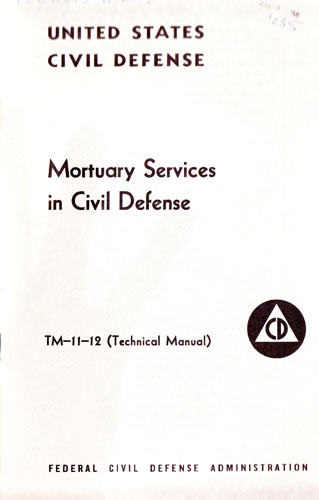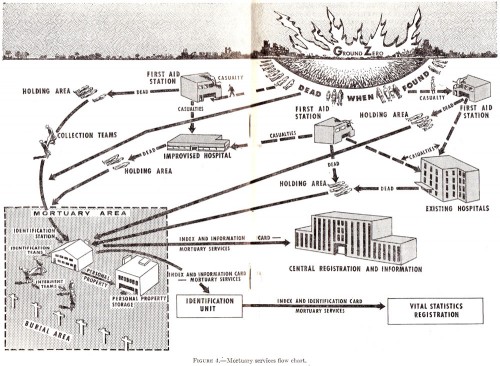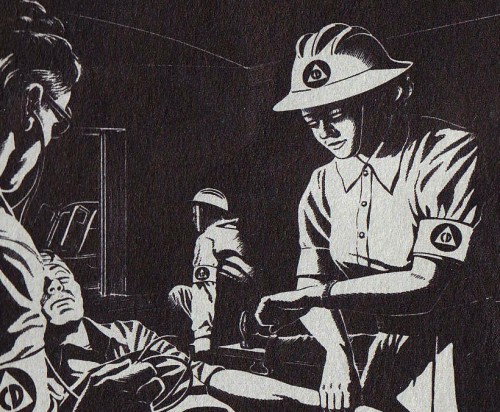Civil Defense is easy to mock, and I’ve done a little mocking of it on here myself. I don’t have strong feelings on the topic. I don’t really buy the argument that it was totally just cynical (or duped) propaganda, but I am also dubious that it would have had a truly significant effect in the event of a full nuclear exchange. I remain fairly on-the-fence on the question about whether it placated people into believing that nuclear war was survivable, or whether it instead scared the bejesus out of people. Did Civil Defense make the bomb seem more acceptable, or more horrific? Or, perhaps more likely, some kind of amalgam of those contradictory emotions?
But it’s hard to argue that Civil Defense wasn’t behind some of the most surreal products of the Cold War. It makes sense that it would: anything that involves trying to make “rational” and “calm” sense of nuclear attacks ends up looking like a bad Dr. Strangelove impersonation when put up against the horror of nuclear war.
Case in point: this week’s document is a pamphlet, “Mortuary Services in Civil Defense,” produced by the Federal Civil Defense Administration in 1956. It’s not your standard “after the bomb falls” guide: it’s not about re-starting a new civilization, it’s about disposing of the mortal remains of the previous one. 1
The pamphlet sets up a dichotomy between “natural disasters” and “nuclear bomb disasters,” which is an interesting linguistic decision. From the pamphlet:
In natural disasters, facilities available in every city can usually take care of the dead. Following an enemy attack with modern nuclear weapons, however, particularly in densely populated areas, existing facilities could not handle the large number of casualties. …
To plan and organize for the disposal of the bodies of millions of civilians killed in an enemy nuclear attack is a grim business, even for those trained and accustomed to the work of mortuaries. The individual care we traditionally bestow on our deceased will not be physically possible when the dead must be counted in the thousands. However, FCDA, with the assistance of its Religious Advisory Committee, is planning for suitable memorial services for the dead in areas devastated by enemy attack.
The pamphlet is essentially a manual for disposing of extremely large volumes of (radioactive) corpses.
For the first few hours after a nuclear bomb disaster, there will be little time for attention to the dead. Later on, after the injured have been cared for and are beginning to be moved out of the devastated area, work with the dead may start. In case of a high degree of radioactive contamination, precautions are advisable to protect mortuary service personnel.
The part I personally found the darkest was a discussion of how to dig appropriate amounts of mass graves:
Mortuary and burial areas selected should have space to accommodate about 25 percent more than the maximum expected number of bodies. … A method of rapid, mechanical grave digging and filling will be needed for the large number of graves required. … If conditions permit, mechanically dug continuous trenches offer the best solution to the burial problem. If the machines available are capable only of digging narrow trenches, bodies can be placed head to foot instead of side by side.
And hey, if you thought you’d seen disturbing government flowcharts before, few compare to this one:
That’s a lot of corpse “holding areas.” And a lot of DEAD arrows. Well. It is a grim topic — and anytime a government publication admits it is a grim topic, you know you’re in trouble.
Maybe I was wrong about it being surreal — there’s a way in which it’s hyperreal, more real in its clinical matter-of-factness than farce could ever be. There’s a very wrong trope out there that depicts the victims of atomic attacks as being “vaporized” or instantaneously disposed of. They’re not. They are crushed, burned, and irradiated. They leave corpses that must be disposed of. I think people find that more disturbing than the “vaporized” idea, because it emphasizes the corporeal suffering that the bomb brings with it.
It’s hard to claim that this particular pamphlet would make anyone feel sanguine about the effects of nuclear weapons. Of course, this particular pamphlet wasn’t really designed for the “general public” — it was a relatively narrow technical manual.
In any case, I think Bert the Turtle would have been a lot more disturbing if Bert, having done his duck-and-cover thing, had immediately started digging trench-graves for his less fortunate animal compatriots…
- Citation: Federal Civil Defense Administration, Mortuary Services in Civil Defense (TM-11-12), (Washington, D.C.: U.S. Government Printing Office, April 1956). This scan was taken from here and cleaned up a bit.[↩]





Do you happen to know of an online repository for these old Civil Defense documents?
I’m looking for a particular one and while finding the occasional reference to hard copies, have been so far unable to find a similar .pdf to the one you posted here.
Thanks for any help
Hi Arnold: I don’t, but if there is one you’re looking for, I’m happy to try and track it down. I have easy access to the Library of Congress, and know quite a few people who work on the history of Civil Defense. Just send me an e-mail if you’re interested.
A really good place to find these documents is the Homeland Security Digital Library (https://www.hsdl.org/). The best part is, they have digital librarians that will help you find specific documents if you’re looking for something in particular.
[…] after the Worst Happens. Two questions along these lines I’ve already discussed in the past: What do you do with all of the dead people? and What will happen to all of our paper-based records? Both of which have […]
[…] Mortuary Services in Civil Defense (2/29/2012) – 2,900 pageviews […]
Actually, if you leave out the radioactivity, there was already a way of estimating how difficult it is to deal with thousands of crushed and burned corpses, and it was from only a decade before. I’m referring, of course, to the mass casualties in Japan and Germany from the Allied bombing campaign. For instance, the U.S. launched a devastating firebombing raid on central Tokyo on the night of March 9-10, 1945 using 334 B-29 Superfortress bombers. The raid lasted some three hours, killing an estimated 100,000+ people and injuring approximately 1,000,000, 41,000 of them seriously. The raid also left approximately 1,000,000 people homeless, as well over a quarter of a million buildings in Tokyo were destroyed by the resulting firestorm. Photos of Tokyo after the raid looked a lot like photos of Hiroshima and Nagasaki after atomic bombs had been dropped on them. It was the highest single day death toll for World War II, and that’s saying a lot given the horrific casualties routinely suffered on the Eastern Front.
“The unusually artistic “Join the Health Services!” image from the back of the pamphlet”
So this is where Charles Burns got his start…